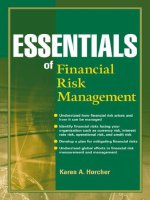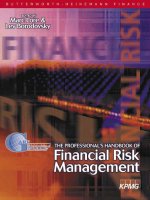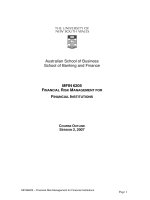Elements of financial risk management chapter 4
Bạn đang xem bản rút gọn của tài liệu. Xem và tải ngay bản đầy đủ của tài liệu tại đây (842.65 KB, 63 trang )
1
Volatility Modeling
Using Daily Data
Elements of
Financial Risk Management
Chapter 4
Peter Christoffersen
Elements of Financial Risk Management Second Edition © 2012 by Peter Christoffersen
Overview
• In this Chapter, we will proceed with the
univariate models in two steps.
• The first step is to establish a forecasting model
for dynamic portfolio variance and to introduce
methods for evaluating the performance of these
forecasts.
• The second step is to consider ways to model
nonnormal aspects of the portfolio return - aspects
that are not captured by the dynamic variance.
Elements of Financial Risk Management Second Edition © 2012 by Peter Christoffersen
2
Overview
• We proceed as follows:
– We start with the simple variance forecasting and
the RiskMetrics variance model.
– We introduce the GARCH variance model and
compare it with the RiskMetrics model.
– We estimate the GARCH parameters using the
quasi-maximum likelihood method.
– We suggest extensions to the basic model
– We discuss various methods for evaluating the
volatility forecasting models.
Elements of Financial Risk Management Second Edition © 2012 by Peter Christoffersen
3
4
Simple Variance Forecasting
• We define the daily asset log-return,
using the daily closing price,
,as
,
•
can refer to an individual asset return or a
portfolio return.
• Based on findings of Chapter 1, we assume for
short horizons the mean value of
is zero.
• Furthermore, we assume that the innovation to
asset return is normally distributed, i.e.
Elements of Financial Risk Management Second Edition © 2012 by Peter Christoffersen
Simple Variance Forecasting
• Where i.i.d. N(0,1) stands for “independently
and identically normally distributed with
mean equal to zero and variance equal to 1.”
• Note that the normality assumption is not
realistic.
Elements of Financial Risk Management Second Edition © 2012 by Peter Christoffersen
5
Simple Variance Forecasting
• Variance, as measured by squared returns, exhibits
strong autocorrelation
• If the recent period was one of high variance, then
tomorrow is likely to be a high-variance day as
well.
• Tomorrow’s variance is given by the simple average
of the most recent m observations :
• However model puts equal weights on the past m
observations yielding unwarranted results
Elements of Financial Risk Management Second Edition © 2012 by Peter Christoffersen
6
Figure 4.1:
Squared S&P 500 Returns with Moving Average Variance
Estimated on past 25 observations. 2008-2009
Elements of Financial Risk Management Second Edition © 2012 by Peter Christoffersen
7
8
Simple Variance Forecasting
• In RiskMetrics system, the weights on past squared
returns decline exponentially as we move
backward in time.
• JP Morgan’s RiskMetrics variance model or the
exponential smoother is given by:
• Separating from the sum the squared return for
where
, we get
Elements of Financial Risk Management Second Edition © 2012 by Peter Christoffersen
,
Simple Variance Forecasting
• Applying the exponential smoothing definition
again we can write today’s variance, , as
• So that tomorrow’s variance can be written
• The RiskMetrics model’s forecast for tomorrow’s
volatility can thus be seen as weighted average of
today’s volatility and today’s squared return.
Elements of Financial Risk Management Second Edition © 2012 by Peter Christoffersen
9
Advantages of RiskMetrics
• It tracks variance changes in a way which is
broadly consistent with observed returns. Recent
returns matter more for tomorrow’s variance than
distant returns.
• It contains only one unknown parameter.
• When estimating λ on a large number of assets,
Riskmetrics found that the estimates were quite
similar across assets and they therefore simply set
for every asset for daily
λ = 0.94 .
variance forecasting.
• In this case, no estimation is necessary, which is a
huge advantage in large portfolios.
Elements of Financial Risk Management Second Edition © 2012 by Peter Christoffersen
10
Advantages of RiskMetrics
11
• Relatively little data needs to be stored in order to
calculate tomorrow’s variance.
• The weight on today’s squared returns is
(1 − λand
) =the
0.06
weight is exponentially decaying to
(1 of
− λsquared
)λ99 = 0return.
.000131After including
on the 100th lag
100 lags of squared returns the cumulated weight is
100
(1 − λ )∑ λτ −1 = 0.998
=1
• We only need about τ100
daily lags of returns in order
to calculate tomorrow’s variance
, σ t2+1 .
Elements of Financial Risk Management Second Edition © 2012 by Peter Christoffersen
12
Advantages of RiskMetrics
• Despite these advantages, RiskMetrics does have
certain shortcomings which motivates us to consider
slightly more elaborate models.
• For example, it does not allow for a leverage effect
and it also provides counterfactual longer-horizon
forecasts.
Elements of Financial Risk Management Second Edition © 2012 by Peter Christoffersen
The GARCH Variance Model
13
• This model can capture important features of returns
data and are flexible enough to accommodate specific
aspects of individual assets.
• The downside of the following models is that they
require nonlinear parameter estimation
• The simplest generalized autoregressive conditional
hetroskedasticity (GARCH) model of dynamic
variance can be written as,
Elements of Financial Risk Management Second Edition © 2012 by Peter Christoffersen
The GARCH Variance Model
• The RiskMetrics model can be viewed as a special
case of the simple GARCH model where
α = 1 − λ , β = λ , s.t. α + β = 1, ω = 0
• However there is an important difference : We can
define the unconditional, or long-run average,
variance to be
Elements of Financial Risk Management Second Edition © 2012 by Peter Christoffersen
14
The GARCH Variance Model
15
+ βis= the
1 case in RiskMetrics, then the long-run
• If α as
variance is not well-defined in that model.
• Thus an important quirk of the RiskMetrics model is that
it ignores the fact that the long-run average variance
tends to be relative stable over time.
• The GARCH model implicitly relies on σ2
• By solving for ω in the long-run variance equation and
substitute it into the dynamic variance equation, we get :
Elements of Financial Risk Management Second Edition © 2012 by Peter Christoffersen
The GARCH Variance Model
• Thus tomorrow’s variance is a weighted average
of the long-run variance, today’s squared return
and today’s variance.
• Ignoring the long-run variance is more important
for longer-horizon forecasting than for forecasting
simply one-day ahead
• A key advantage of GARCH models for risk
management is that the one-day forecast of
2
σ
t +1|t is given directly by the model
variance ,
2
σ
t +1
as
Elements of Financial Risk Management Second Edition © 2012 by Peter Christoffersen
16
The GARCH Variance Model
• Consider forecasting the variance of the daily
return k days ahead; the expected value of future
variance at horizon k is
Elements of Financial Risk Management Second Edition © 2012 by Peter Christoffersen
17
The GARCH Variance Model
18
• The conditional expectation
refers to taking the
expectation using all the information available at the end
of day t, which includes the squared return on day t
itself.
• (α + β )is the persistence.
• A high persistence - (α + β close
to 1- implies that shocks
)
that push variance away from its longrun average will
persist for a long time
• Similar calculations for RiskMetrics model reveal
• as α + β = 1 and σ2 is undefined
Elements of Financial Risk Management Second Edition © 2012 by Peter Christoffersen
The GARCH Variance Model
19
• Thus, persistence in this model is 1, which
implies that a shock to variance persists forever
• An increase in variance will push up the
variance forecast by an identical amount for all
future forecast horizons.
• RiskMetrics model ignores the long-run variance
when forecasting.
• If α + β is close to one, then the two models
might yield similar predictions for short
horizons, k, but their longer horizon implications
are very different.
Elements of Financial Risk Management Second Edition © 2012 by Peter Christoffersen
The GARCH Variance Model
20
• If today is a low-variance day then RiskMetrics model
predicts that all future days will be low variance.
• The GARCH model assumes that eventually in the future
variance will revert to the average value
• The forecast of variance of K-day cumulative returns
• We assume that returns have zero autocorrelation, then the
variance is simply
Elements of Financial Risk Management Second Edition © 2012 by Peter Christoffersen
The GARCH Variance Model
• So, in the RiskMetrics model we get
• But in GARCH model, we get
• If the RiskMetrics and GARCH model have
2
2
2
identical σ t +1 , and if, σ t +1 < σ
, then the
GARCH variance forecast will be higher than the
RiskMetrics forecast.
Elements of Financial Risk Management Second Edition © 2012 by Peter Christoffersen
21
The GARCH Variance Model
• Assuming Riskmetrics model, if the data looks
more like GARCH will give risk managers a false
sense of the calmness
of
the market in the future,
2
2
σ t +1 < σ .
when the market is calm today and
• Fig.4.2 illustrates
this
crucial
point.
2
σ t +1:t + K K for K = 1,2,...,250
• We plot for both the RiskMetrics and the
GARCH model starting
from
α = 0.05 and
β =a0.low
90 σ2t+1 and
setting
.
• The long run variance in the figure is σ2 =
0.000140
Elements of Financial Risk Management Second Edition © 2012 by Peter Christoffersen
22
Figure 4.2:Variance Forecast for 1-250 Days
Cumulative Returns
Elements of Financial Risk Management Second Edition © 2012 by Peter Christoffersen
23
The GARCH Variance Model
24
• An inconvenience shared by the two models is that
the multi-period distribution is unknown even if the
one-day ahead distribution is assumed to be normal
• Thus while it is easy to forecast longer-horizon
variance in these models, it is not as easy to
forecast the entire conditional distribution.
• This issue will be further analyzed in Chap. 8
Elements of Financial Risk Management Second Edition © 2012 by Peter Christoffersen
Maximum likelihood Estimation
• GARCH model contain a number of
unknown parameters that must be
estimated.
• The conditional variance is an unobserved
variable, which must be implicitly estimated
along with the parameters of the model.
Elements of Financial Risk Management Second Edition © 2012 by Peter Christoffersen
25









